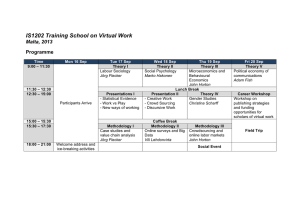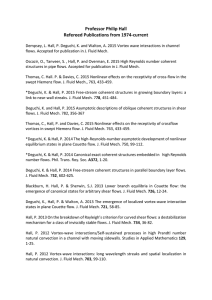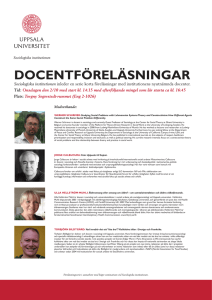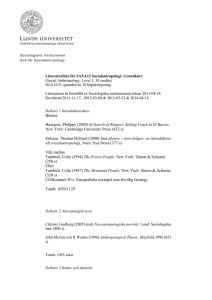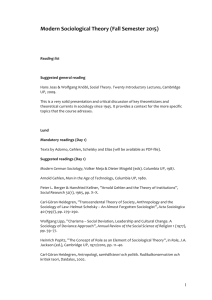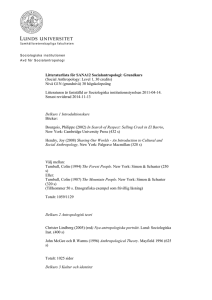5. Goertler instability.ppt
advertisement
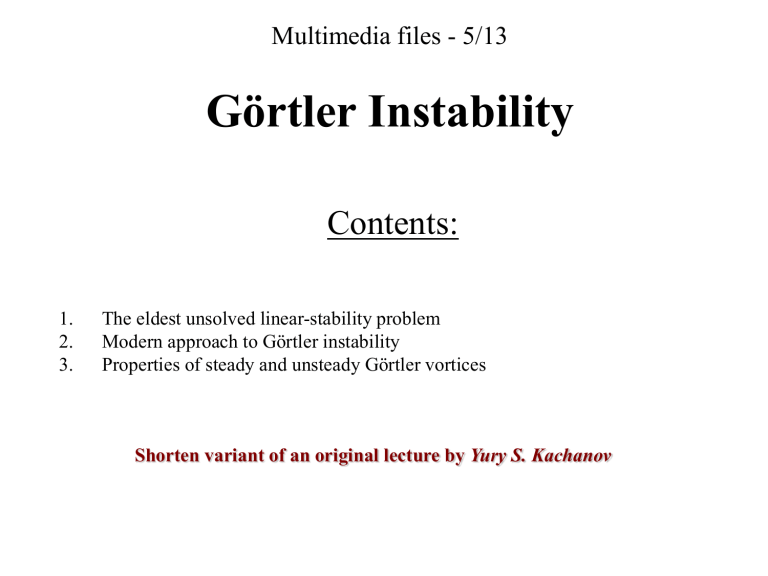
Multimedia files - 5/13 Görtler Instability Contents: 1. 2. 3. The eldest unsolved linear-stability problem Modern approach to Görtler instability Properties of steady and unsteady Görtler vortices Shorten variant of an original lecture by Yury S. Kachanov 1. The Eldest Unsolved LinearStability Problem Why Is the Görtler Instability So Important? • Görtler instability may occur in flows near curved walls and lead to amplification of streamwise vortices, which are able to result in: • (i) the laminar-turbulent transition, • (ii) the enhancement of heat and mass fluxes, • (iii) strong change of viscous drag • (iii) other changes important for aerodynamics Görtler Instability on Curved Walls. When Does It Occur? Stable Sketch of Steady TheGörtler necessary and vortices sufficient condition for the flow to be stable is: (i) d(U2)/dy < 0 for concave wall or (ii) d(U2)/dy > 0 for convex wall. Floryan (1986) Otherwise the instability may occur Floryan (1991) Görtler (1956) Why Does Görtler Instability Appear? Governing parameter is Görtler number As far as then R(y≥d) That is why curvature of streamlines is always greater inside boundary layer than outside of it This is similar to unstable stratification (a buoyancy force), which leads to appearance of Görtler instability! d R(y<d) Fs Linear Stability Diagrams and Measurements Neutral curve Neutral curve Standard representation: (G,b)-plane Representation convenient in experiment: (G,L)-plane Floryan & Saric (1982) Linear Stability Diagrams and Measurements In other words, (1984) conclude modal approach in invalid Hall (1984) hasHall made conclusion thatthat neutral curve does not exist forfor b ≤these O(1)b Görtler (1941) Hämmerlin (1955b) Growing vortices Hämmerlin (1961) Schultz-Grunow (1973) Decaying vortices Kabawita & Meroney (1973-77) Smith (1955) Hämmerlin (1955a) Floryan & Saric (1982) b Experimental check of right branch of the neutral stability curve Experiments by Bippes (1972) Kabawita & Meroney (1973-77) b Left branch of the neutral curve obtained from different versions of linear stability theory After Herbert (1976) and Floryan & Saric (1982) Amplification of Görtler Vortices • Any attempts (until recently) to find at least one figure showing direct comparison of measured Comparison of Experimental Amplification amplification curves with linear theory Curves of Görtler instability failed!!! for Görtler Vortex Amplitudes • No quantitative agreement between experiment and with the Linear Stability Theory linear stability theory was obtained for disturbance growth rates! • “Theoretical growth rates obtained for the experimental conditions were much higher than the measured growth rates” (Finnis & Brown, 1997) 2. Modern Approach to Görtler Instability Amplification of Görtler Vortices • Thus, by the beginning of the present century the problem of linear Görtler instability remained unsolved (after almost 70 years of studies) even for the classic case of Blasius boundary layer! • Whereas other similar problems (like TollmienSchlichting instability, cross-flow instability, etc.) have been solved successfully Why Does This Problem Occur? • Very poor accuracy of measurements at zero frequency of perturbations (perhaps ±several%) • Researchers were forced to work at very large amplitudes (10% and more) resulted in nonlinearities • Near-field effects of disturbance source (transient growth, etc.) were not taken into account properly in the most of cases • Meanwhile, there effects (i.e. the influence of initial spectrum, or shape of disturbances) are very important for Görtler instability (because ar = 0 for steady vortices) • Range of validity of Hall’s conclusion on non-applicability of the eigenvalue problem (i.e. on infinite length of the disturbance source near-field) remained unclear Steady and Unsteady Vortices • Almost all previous studies were devoted to steady Görtler vortices, despite the unsteady ones are often observed in real flows • Unsteady Görtler vortices seem to dominate at enhanced free-stream turbulence levels, e.g. on turbine blades Main Fresh Ideas 1. 2. To To measure investigate everything essentially accurately unsteady Görtler vortices for steady case important for practical How? applications To tune-off from the zero disturbance frequency and to work with quasi-steady Görtler vortices instead of exactly steady ones Boiko (theory), Ivanov, Kachanov, Mischenko (2005-2007) What Is Quasi-Steady? Periodof vortex oscillation >> Timeof flow over model or X-wavelengthof vortex >> X-sizeof exper. model E.g. for f = 0.5 Hz, U = 10 m/s, L = 1 m Periodof vortex oscillation = 2 sec Timeof flow over model = 0.1 sec Boiko (theory), Ivanov, Kachanov, Mischenko (2005-2007) Goals • To develop experimental and theoretical approaches to investigation of unsteady Görtler vortices (including quasi-steady ones) • To investigate experimentally and theoretically all main stability characteristics of a boundary layer on a concave surface with respect to such vortices • To perform a detail quantitative comparison of experimental and theoretical data on the boundary-layer instability to unsteady (in general) Görtler vortices Boiko (theory), Ivanov, Kachanov, Mischenko (2005-2007) Wind-Tunnel T-324 Experiments are conducted at: Fan is there Free-stream speed Ue = 9.18 m/s and Free-stream turbulence level e = 0.02% Measurements are performed with a hot-wire anemometer Test section Settling chamber Boiko (theory), Ivanov, Kachanov, Mischenko (2005-2007) Experimental Model (1) – wind-tunnel test-section wall, (2) – plate, (3) – peace of concave surface with radius of curvature of 8.37 м, (4) – wall bump, (5) – traverse, (6) – flap, (7) – disturbance source. Boiko (theory), Ivanov, Kachanov, Mischenko (2005-2007) Experimental Model Adjustable Wall Bump Traversing mechanism Disturbance source Test-plate with the concave insert, adjustable wall bump, and traverse installed in the wind-tunnel test section Boiko (theory), Ivanov, Kachanov, Mischenko (2005-2007) Boundary Layer 1.2 1 U/Ue 0.8 x = 700 мм x = 700 мм x = 900 мм x = 900 мм Блазиус Blasius 0.6 0.4 0.2 0 0 1 2 3 4 5 6 y/d 1 Measured mean velocity profiles and comparison with theoretical one Boiko (theory), Ivanov, Kachanov, Mischenko (2005-2007) Ranges of Measurements on Stability Diagrams Tollmien-Schlichting mode First mode of Görtler instability f = 0 Hz Floryan and Saric (1982) f = 20 Hz Boiko et al. (2005-2007) Disturbance Source U0 Undisturbed flow кtoдинамикам speakers The measurements were performed in 22 main regimes of disturbances excitation in frequency range from 0.5 and 20 Hz for three values of spanwise wavelength: lz = 8, 12, and 24 mm Boiko (theory), Ivanov, Kachanov, Mischenko (2005-2007) Excited Initial Disturbances 0.06 0.6 % A1, м/c 360 A1_norm, Exper. V Approx. Series2 270 j , deg 0.04 0.4 180 0.02 0.2 90 0.0 0 Fi1_corr, Exper.deg Approx. Series2 0 440 444 448 452 456 460 464 468 472 476 480 484 z, mm 440 444 448 452 456 460 464 468 472 476 480 484 z, mm Spanwise distributions of disturbance amplitude and phase in one of regimes lz = 24 mm, f = 11 Hz, x = 400 mm. Boiko (theory), Ivanov, Kachanov, Mischenko (2005-2007) Spectra of Eigenmodes of Unsteady Görtler-Instability Problem F = 0.57 F = 9.08 F = 22.7 1st mode of discrete spectrum 2nd mode of discrete spectrum Continuous-spectrum modes Görtler number G = 17.3, spanwise wavelength L = 149 Boiko (theory), Ivanov, Kachanov, Mischenko (2005-2007) Wall-Normal Profiles for Different Spectral Modes Mean velocity 1st mode 2nd mode U∂U/∂y (non-modal) 1st mode 2nd mode 1st-mode critical layer Calculations based on the locally-parallel linear stability theory performed for G = 17.3, F = 0.57, L = 149 Boiko (theory), Ivanov, Kachanov, Mischenko (2005-2007) Disturbance-Source Near-Field. Transient (Non-Modal) Growth Transient (non-modal) behavior Transient decay in experiment Source near-field Disturbance source Transient decay in theory 1st Modal behavior: discrete-spectrum Görtler mode Transient growth in theory Separation of 1st unsteady Görtler mode due to mode competition Boiko (theory), Ivanov, Kachanov, Mischenko (2005-2007) 3. Properties of Steady and Unsteady Görtler Vortices Evolution of Quasi-Steady and Unsteady Görtler Vortices Streamwise component of velocity disturbance in (x,y,t)-space (lz = 12 mm) Frequency f = 0,5 Hz (a quasi-steady case) Frequency f = 14 Hz (an essentially unsteady case) Boiko (theory), Ivanov, Kachanov, Mischenko (2005-2007) Shape of Quasi-Steady Görtler Vortices (f = 2 Hz) Ue Ue Experiment Theory Boiko (theory), Ivanov, Kachanov, Mischenko (2005-2007) Shape of Unsteady Görtler Vortices (f = 20 Hz) g Ue Ue Experiment Theory Boiko (theory), Ivanov, Kachanov, Mischenko (2005-2007) Check of Linearity of the Problem 180 0.1 jdeg 1, град A1/A1o 0.08 Ao Ao/2 Ao Ao/2 90 0.06 0 0.04 -90 0.02 -180 0 400 500 600 700 800 x, mm 900 400 500 600 700 800 x, mm 900 Streamwise evolution of Görtler-vortex amplitudes and phases for two different amplitudes of excitation Boiko (theory), Ivanov, Kachanov, Mischenko (2005-2007) Wall-Normal Disturbance Profiles A/A1.2 max Dependence on streamwise coordinate, lz = 8 mm 180 90 f-f o, deg l z = 8 mm, f = 5 Hz Experiment PSE LST 1 Experiment PSE LST 0.8 l z = 8 mm, f = 5 Hz 0.6 0.4 x = 900 400 mm 500 600 700 800 0.2 x = 900 400 mm 500 600 700 800 0 0 0 1 2 3 4 5 -90 First mode of unsteady Görtler instability in LST -180 0 1 2 3 4 5 y/d 6 Boiko (theory), Ivanov, Kachanov, Mischenko (2005-2007) y/d 6 Eigenfunctions of Görtler Vortices Dependence on frequency for lz = 12 mm, G = 17.2 A/A1.2 max Experiment PSE LST 1 0.8 l z = 12 mm, x = 900 mm 90 l z = 12 mm, x = 900 mm f = 20.0 0.5 Hz 2.0 5.0 8.0 11.0 14.0 17.0 Hz f-f o, deg 0 0.6 0.4 -90 0.2 -180 0 Hz 0.5 Hz 2.0 5.0 8.0 11.0 14.0 17.0 f = 20.0 0 1 2 3 4 Experiment PSE LST -270 -360 0 1 2 3 4 5 y/d 6 Boiko (theory), Ivanov, Kachanov, Mischenko (2005-2007) 5 y/d 6 Eigenfunctions of Görtler Vortices Dependence on spanwise wavelength, x = 900 mm, G = 17.2, f = 5 Hz A/A1.2 max 1 0.8 180 f = 5 Hz, x = 900 mm 0.6 f = 5 Hz, x = 900 mm l z = 24.0 8.0 mm 12.0 mm 0.4 90 f-f o, deg Experiment PSE LST l z = 24.0 8.0 mm 12.0 mm 0.2 0 0 0 -90 Experiment PSE LST 1 2 2 3 4 5 First mode of unsteady Görtler instability in LST -180 0 1 3 4 5 y/d 6 Boiko (theory), Ivanov, Kachanov, Mischenko (2005-2007) y/d 6 Growth of Amplitudes and Phases of Görtler Modes (f = 2 Hz) 10 11 15 13 1st Goertler mode in far field Mixture of modes in near field LST PSE A/A1 G 17 mm 8 mm 12 llzz==24 Phase amplification is almost independent of the spanwise wavelength f n/ 1 1st Goertler mode in far field Mixture of modes in near field LST PSE 0.6 0.4 f = 2.0 Hz llzz==24 12 8 mm mm f = 2.0 Hz 0.1 390 490 590 690 790 Dependence on spanwise wavelength mm x,890 0.2 0 390 490 590 690 Boiko (theory), Ivanov, Kachanov, Mischenko (2005-2007) 790 x,890 mm Growth of Amplitudes and Phases of Görtler Modes (lz = 8 mm) 10 11 15 13 1st Goertler mode in far field Mixture of modes in near field LST PSE A/A1 G 17 l z = 8 mm The non-local, non-parallel stability theory (parabolic stability equations) provides the best agreement with experiment f n/ 1 15 13 G 17 1st Goertler mode in far field Mixture of modes in near field LST PSE 3 f = 17.0 2.0 Hz 5.0 8.0 11.0 14.0 Hz 11 2 l z = 8 mm f = 17.0 2.0 Hz 5.0 8.0 11.0 14.0 Hz 0.1 390 490 590 690 790 Dependence on frequency x,890 mm 1 0 390 490 590 690 Boiko (theory), Ivanov, Kachanov, Mischenko (2005-2007) 790 x,890 mm Growth of Amplitudes and Phases of Görtler Modes (lz = 12 mm) 10 11 15 13 1st Goertler mode in far field Mixture of modes in near field LST PSE A/A1 G 17 l z = 12 mm The non-local, non-parallel stability theory (parabolic stability equations) provides the best agreement with experiment f n/ 1 15 13 G 17 1st Goertler mode in far field Mixture of modes in near field LST PSE 3 Hz 0.5 Hz 2.0 5.0 8.0 11.0 f = 14.0 11 2 l z = 12 mm f = 14.0 0.5 Hz 2.0 5.0 8.0 11.0 Hz 0.1 390 490 590 690 790 Dependence on frequency for lz = 12 mm mm x,890 1 0 390 490 590 690 Boiko (theory), Ivanov, Kachanov, Mischenko (2005-2007) 790 x,890 mm Frequency Dependence of Increments and Phase Velocities of Görtler Modes lz = 8 mm (b = 0.785 rad/mm) 1 -a i0.005 , mm-1 Сx/Ue lz = 8 mm 0.004 l z = 8 mm 0.8 0.003 0.6 0.002 0.4 Experiment LST PSE 0.001 0 Experiment LST PSE 0.2 -0.001 0 0 5 10 15 Increments of 1st Görtler mode at G ≈ 15 f , Hz 20 0 5 10 15 f , Hz 20 Phase velocities of 1st Görtler mode at G ≈ 15 Boiko (theory), Ivanov, Kachanov, Mischenko (2005-2007) Frequency Dependence of Increments and Phase Velocities of Görtler Modes lz = 12 mm (b = 0.524 rad/mm) 1 -a i0.005 , mm-1 Сx/Ue lz = 12 mm 0.004 l z = 12 mm 0.8 0.003 0.6 0.002 0.4 Experiment LST PSE 0.001 0 Experiment LST PSE 0.2 -0.001 0 0 5 10 15 Increments of 1st Görtler mode at G ≈ 15 f , Hz 20 0 5 10 15 f , Hz 20 Phase velocities of 1st Görtler mode at G ≈ 15 Boiko (theory), Ivanov, Kachanov, Mischenko (2005-2007) Frequency Evolution of Stability Diagram for Görtler Vortices Tollmien-Schlichting mode Growing disturbances (experiment) Attenuating disturbances (experiment) Neutral points (experiment) Contours of increments (LPST) Hz 0.5 14 17 20 11 2 8 5 Гц First mode of Görtler instability Boiko (theory), Ivanov, Kachanov, Mischenko (2005-2007) Conclusions • Modal approach works for Görtler instability problem (steady and unsteady) for at least b ≥ O(1) • Very good quantitative agreement between experimental and theoretical linear-stability characteristics has bee achieved now for steady Görtler vortices (for the most dangerous 1st mode) • Similar, very good agreement is obtained also for unsteady Görtler vortices (again for the 1st, most amplified, mode) • The non-local, non-parallel theory predicts better the most of stability characteristics (to both steady and unsteady Görtler vortices) Recommended Literature 1. Floryan J.M. 1991. On the Görtler instability of boundary layers J. Aerosp. Sci. Vol. 28, pp. 235‒271. 2. Saric W.S. 1994. Görtler vortices. Ann. Rev. Fluid Mech. Vol. 26, p. 379‒409. 3. A.V. Boiko, A.V. Ivanov, Y.S. Kachanov, D.A. Mischenko (2010) Steady and unsteady Görtler boundary-layer instability on concave wall. Eur. J. Mech./B Fluids, Vol. 29, pp. 61‒83.
